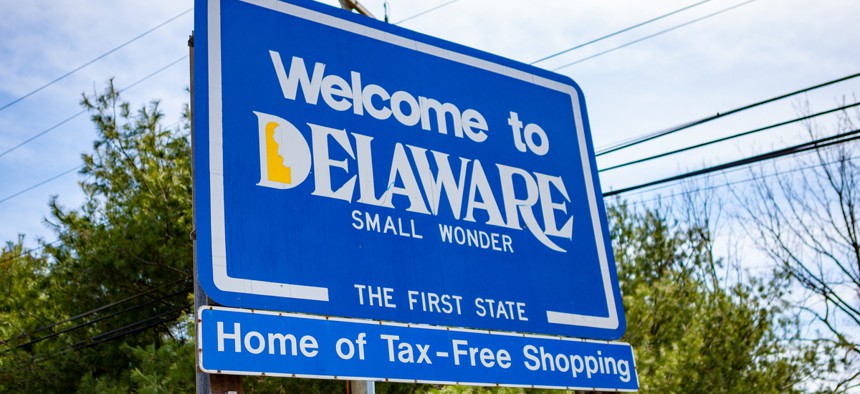Delaware Is Dead Set on Putting Your State’s Broadband to Shame

Welcome to Delaware. Shutterstock

Connecting state and local government leaders
“My hope is in the next 24 months, we’re going to eradicate this rural broadband issue,” James Collins, state chief information officer, told Route Fifty.
Delaware is a national leader in broadband adoption and speed. However, the state is not resting on its laurels, and the chief information officer has a plan to bring broadband connectivity to rural areas using high-speed wireless technologies.
“My hope is in the next 24 months, we’re going to eradicate this rural broadband issue,” James Collins, state chief information officer, told Route Fifty in an interview at the National Association of State Chief Information Officers midyear meeting in Baltimore.
The state has made substantial investments in broadband. According to Collins, they have invested “somewhere between one and four million” in economic development and grant funds. That investment spurred private sector support to the tune of $30 million of investment from the private sector and about 700 miles of fiber.
“We’ve made a conscious decision that we don’t think it’s the government’s business to be in competition with the private sector as it relates to broadband and other things,” Collins explained. “So we have been trying to incentivize them to build out in areas where it wouldn’t otherwise be economically feasible for them to do so.”
That effort helped Delaware build a broadband environment where 98 percent of those in the state have internet speeds of 4 megabits-per-second or higher, with an average speed above 25 mbps (the FCC’s standard for the definition of high-speed broadband), according to Akamai’s 2017 State of the Internet Report.
“The majority of our citizens have great access and great internet speeds,” Collins said.
However, while Delaware is one of the smallest states, it is actually more rural than most other states; a third of its population lives in rural areas and small communities. In some parts of the state, such as parts of western Kent and Sussex counties, broadband speeds are not keeping up with the rest of Delaware’s residents.
As Dwayne Kilgo, director of Information Technology for Sussex County, explained to Coastal Point, a local newspaper, the county is ranked 438th in terms of broadband service.
“Affordable wired broadband is still out of reach for many rural areas, where access beyond 10 megabits is rare,” Kilgo said.
Enter an ambitious wireless plan to solve the “last-mile problem.”
The issue is that getting high-speed broadband to those who live the farthest afield is the most expensive, therefore making it impossible make a return on investments in rural areas and smaller communities.
In Delaware, as in many rural communities, “the last mile is not really the last mile,” Collins explained. “It’s the last 15 or 20 miles.”
Collins and his team in Delaware are hoping to solve this through complementing their success in promoting wired connections with a wireless strategy.
“We have wireless pilots going on right now and we’re going to release an RFP in the coming months to bring in a wireless internet provider,” Collins explained. “The vendor that we’re working with on the pilot ... they’re getting 5- to 10-mile radius from each tower.”
The state, along with the counties, plan to provide the winning company with access to state and county-owned wireless towers at discounted rates for two years in order to spur broadband access.
Current pilot projects are ongoing in Rehoboth and Seaford, care of WhyFly and Bloosurf, respectively. According to Bloosurf’s website, they deliver up to 25 mbps to homes and up to 1 gigabit-per-second connectivity for businesses. WhyFly, meanwhile, claims to provide “speeds over 75 Mbps and up to 120Mbps download & upload for a flat fee of $55 / month, no contract, no equipment rentals, no shenanigans, & no gluten.”
According to Delaware’s Department of Technology and Information website, contracts will be awarded by May 16.
Watch the full interview or check out our other key takeaways below.
On Delaware’s Open Data Portal:
“I think the general consensus today is hunting and pecking around for different government services and information today in the different silos is just something of the past, in something I called the manila folder age,” Collins said. “In the information age we should be serving up information that is transparent and readily available to citizens. So what we tried to do initially was just take information—the low-hanging fruit—information that was on various websites throughout the state and just bring it into one site and then put it out there in multiple formats for people to consume it.”
“So now, we’ll be able to take things to the next level. Our transportation department is doing some really innovative things. Our department of environmental and natural resources is doing some great things … they’re telling literally stories with the data on the open data portal.”
On Delaware’s Blockchain Efforts:
The state recently enacted legislation it to allow blockchain to be used in corporate transactions.
“Most people know Delaware is a corporate capital of the world. Our Department of State, Division of Corporations are actually the ones that run that department and they do a fabulous job.”
“They are actually working with their major stakeholders from registered agents to community attorneys to figure out how blockchain fits into that corporate franchise. And they’re also working with some subject matter experts.”
“I suspect we’ll see some proof of concepts in the very near future ... I’ve seen some early reports and it’s going to be really good.”
“I think they want to leverage things like smart contracts that automatically track assets, that track stocks, that track transactions in a transparent way where everyone involved in the transaction can see the status of it.”
Mitch Herckis is Senior Director of Programs for Government Executive’s Route Fifty and is based in Washington, D.C.

NEXT STORY: AI: How to maximize the benefits, avoid the pitfalls





